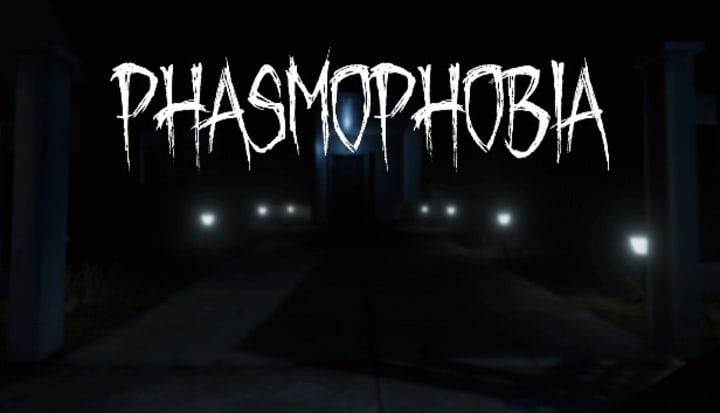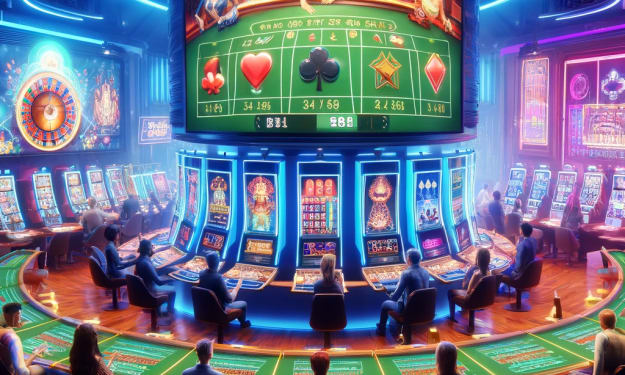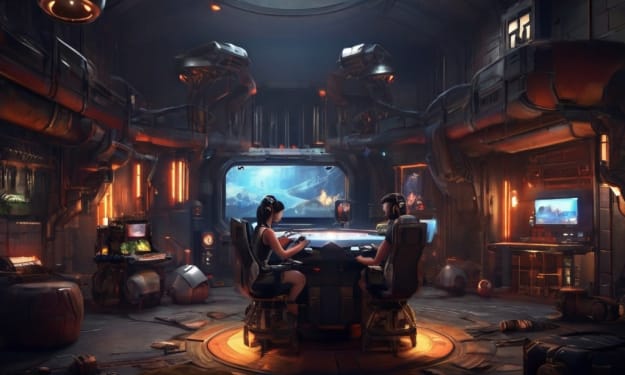The Evolution of Ghost Hunting in Gaming
From Bustin' to Clue Huntin'

The hum of silence echoed throughout my ears, masked only by my voice bouncing off the walls of the empty room. A red light from my voice recorder blinked steadily from the floor, basking the bedroom in a soft and repetitious glow. It gave me a brief second to survey the emptiness and try to catch the ominous shadow that may be lurking in a corner. But I sat there for an hour, my questions answered only by the persistent quiet. There was no thrill of a tap on my shoulder or a tug on my jacket. No disembodied voice spoke to me with indecipherable messages. It was just me, the silence, and the lingering inquiry that brought me to that house in the first place - is there life after death?
It’s a question we still don’t have an answer to, though I air on the side of hoping there is more to life than what we see. But there are those that would have you believe the proof is irrefutable as they step forward with claims of encounters with demonic entities and bouts of life-ruining possession. For much of mainstream media, the craze of paranormal investigating started with Ed and Lorraine Warren, a duo of questionable intent that took ghost hunting from a fringe concept to something that intrigued the media. The reality, though, is that our fascination with the prospect of a spirit world dates back centuries ago when the elite gathered around tables and charlatans put on magic shows.

Today, paranormal investigating is a far cry from when I first started sitting in pitch black rooms. Thanks to the brilliant business acumen of Zak Bagans, everything’s a demon and nobody is safe. And while I quite loath the direction the trade has gone, in particular the countless doctored videos on social media being passed as real, I do think some good came of it. Without the overexcited personality of Bagans and the long-running success of Ghost Adventures, I don’t think games like Phasmophobia would exist. And without Phasmophobia, my Steam library would be many titles shy.
But Phasmophobia and its inspired works are far from the first paranormal games to pit man against spirit. In fact, the evolution of ghost hunting in video games can be traced back to the 1980s, when a quartet of boys in tan took on a supernatural threat of oversized Twinkie proportions.
Ghost Hunting, Ghostbusting, and Ghost Mastery
Even long before I purchased my first EMF meter and looked into joining the American Society for Psychical Research, gamers were going toe-to-toe with paranormal threats of all kinds. Atari and most early consoles featured some spooky threat, but Ghostbusters (1984) first put the concept of hunting ghosts and seeking out the paranormal in the palms of gamers. Sure, the NES Ghostbusters game was very basic, and finding ghosts was kind of a crapshoot, but it opened a floodgate of related games, from the 1987 The Real Ghostbusters arcade to the punishingly difficult Sega Genesis title.
Ghostbusters made quite the splash in gaming, especially when the 2009 Ghostbusters: The Video Game launched as the answer to a third movie, but it was far from the only opportunity players had at tracking down supernatural threats. Titles like Koei Tecmo’s Fatal Frame series, which was first released in 2001, put players on the defensive with a mysterious antique camera that eradicates ghosts with the click of a shudder. Two years after players first manned the Camera Obscura, SCE Cambridge Studio introduced them to Lazarus Jones and Ghosthunter. Jones, a Detroit police officer, inadvertently turns off a ghost containment unit, leading him down a dangerous path full of spectral foes. The PS2 exclusive was absolutely a take on the Ghostbusters formula, replacing proton packs with an array of ghost-eradicating firearms. Jones was even equipped with a ghost trap of his own, which looks suspiciously similar to the ghost trap of Extreme Ghostbusters.

As much as we love seeking out the ghouls and ghosts of games past as investigators and hunters, one game twisted the formula and put us in control of these spectral fiends. Ghost Master, which was released between Fatal Frame and Ghosthunter, gave players an arsenal of supernatural threats used to terrify the fine people of Gravenville. While much of the game was about resource management and finding the right combination of scares, later levels introduced the Ghostbreakers, a team dedicated to eradicating Gravenville’s supernatural threat. Only the best Ghost Master could impede their progress and secure a healthy future for the dearly departed.
Players have been battling the supernatural for decades, and some developers have taken advantage of our love for the spooky. But it’s safe to say that some devs have done more with that love than others, which shifts the spotlight to a solo developer and a co-op multiplayer that sent a team of players right into the arms of evil. In 2019, Shawn Hitchcock released Pacify, a four-player co-op thriller that can be credited for sparking a trend in gaming we’re seeing today. As the Paranormal Activity Helpers, Inc, players are tasked with pacifying a supernatural threat before it eradicates them. Using their wits, the team must burn ten dolls to quell the evil and survive the haunt. Pacify may have set the stage for bringing paranormal investigators into modern gaming, but it was Kinetic Games, an indie team in the United Kingdom, that really lit the fire.
From Hunting Ghosts to Hunting Clues: How Phasmophobia Changed the Playing Field

If you’ve spent any amount of time in the horror gaming airwaves, the name Phasmophobia has likely graced your eyes quite a bit. Where most supernatural games task players with removing a threat, Phasmophobia forces players to face it, study it, and leave without becoming another victim of the horrifying apparitions. The game is Ghost Hunting 101, providing players with actual tools used in real-world investigations to gather clues to uncover the type of spirit they’re dealing with. With EMF meters and UV lights in hand, it’s a race against the proverbial clock as ghouls, demons, poltergeists, wraiths, and a full rogue’s gallery of ghost types won’t just wait around to be discovered. Agitated and deadly, they’ll make their presence known with hunts that send investigators running and cowering wherever they can find cover.
Though similar games predate Phasmophobia’s release, Kinetic Games’ title very quickly gained notoriety and became the “game to player” for horror streamers, and with that popularity came titles very clearly inspired by the format. Devour, Ghost Hunters Corp, Forewarned, Obsideo, and Midnight Ghost Hunt all build upon (or blatantly copy) the concepts behind Pacify and Phasmophobia, pitting ghost hunters and paranormal investigators against inescapable horrors.
The problem with a genre growing so popular that it spawns copycat after copycat is very simply about oversaturation. It must evolve, else players will grow tired of seeing the same concepts used and reused. And though something like Phasmophobia may seem like the peek of sending players to investigate spooky locations, the genre is on the verge of evolving beyond itself thanks to the efforts of Everyday Agents and the February 25 release of They Die Tomorrow.

In a strange sense, They Die Tomorrow could serve as a prequel to Phasmophobia. Players gear up and set out to the scene of a murder before it happens to identify the would-be killer. If they fail, it’s a bloodbath that, if we’re creating fan fiction, could result in the manifestations players hunt in Phasmophobia. But They Die Tomorrow isn’t a Phasmophobia clone with a new story. Everyday Agents has enhanced the experience with all-new equipment, multiple ways for players to succumb to the villainy of the killer, multiple starting points, and a variety of ways to play.
They Die Tomorrow is just one example of how the genre popularized by Phasmophobia can advance, and it’s very likely after the game’s February 25 release date, more will come to the surface. But will that mean our beloved ghost hunts and extensive investigations will soon be lost to obscurity? For that answer, let’s circle back to the ongoing legacy of Zak Bagans and Ghost Adventures. With minimal changes to the formula that Bagans concocted in 2008, the series has continued to spur interest in the supernatural and paranormal investigations. It molded a new way of looking at our potential spectral visitors, depicting them as villainous and vile. It’s developed a trend that’s crossed over onto every social media platform as claims of demonic encounters accompany every harmless video of a speck of dust. For those that really aim to seek answers about the prospects of an afterlife, it’s not a welcomed trend. However, for the developers thriving off the idea of murderous hauntings, it’s an evolution they surely welcome.
About the Creator
Mark LoProto
Writer | Avid Gamer | Horror Enthusiast | A Voice for All Industries
Writing and building communities are my passions
Featured on all corners of the Internet






Comments
There are no comments for this story
Be the first to respond and start the conversation.